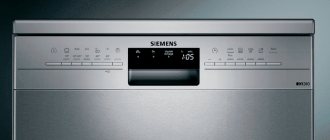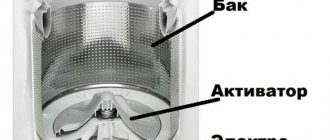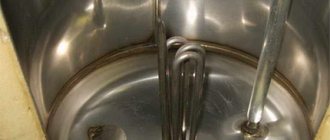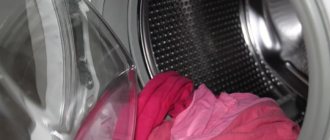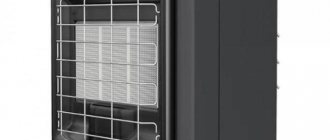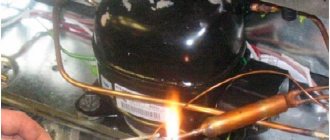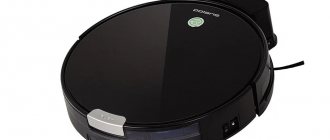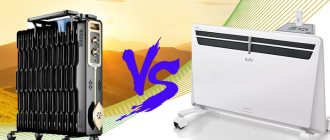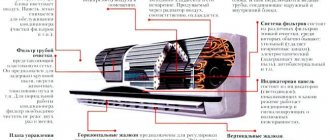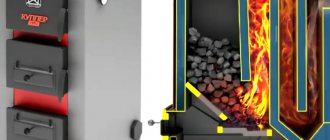The water in an electric water heater, or as it is also called in a boiler, is heated by heating elements. This is a tubular boiler with a wire spiral inside, which is heated by current. To avoid short circuits, sand is poured between the tube and the wire. It has dielectric properties.
An electric water heater is a tank that has outlets for the movement of cold and hot liquid flows. The heating element (heating element) is located inside the container. During operation, limescale forms on its surface and salts are deposited. As the layer thickness increases, the heat transfer of the heating element decreases. It takes more and more time to heat the water in the tank, which entails an increase in the amount of payment for consumed electricity.
Installing water purification filters at the entrance to the water supply system reduces the level of the problem. An innovative solution was the use of a dry heating element in the boiler design. A dry heating element in a boiler is placed in a metal flask. There is no direct contact with the liquid inside the tank. Many companies have developed and are producing models with a dry-type heating element. It increases the service life of the device, its maintenance has become easier. Saving money on electricity bills when choosing a dry-type water heater is the best argument in its favor for the consumer.
Types of dry heating elements
Manufacturers are constantly working to improve the design of the innovative heating element. Three types have been developed:
- a flask filled with oil with a high thermal conductivity, which saves electricity when heating water;
- flask with air;
- The flask together with the spiral is filled with sand.
A dry heating element for a boiler is safe to operate. In a conventional boiler, a burnt wire touches the walls of the tube and causes stress on the body of the water heater. When a dry heating element burns out, it simply stops working. The wire does not come into contact with water.
Flaws
Since ideal things do not exist in nature, dry heating elements also have negative sides. True, there are not so many of them.
A dry heating element can be exclusively straight. Therefore, they are used in models with a volume of at least 30 liters. So if you need to purchase a “baby” one of 10–20 liters, this option will not work.
But the main disadvantage of a dry heating element is its high cost. Models equipped with such a heating element usually cost no less than one and a half times more than traditional water heaters with a “boiler”. Whether such a unit is worth the money spent on it, everyone must decide for themselves.
Product design
It is possible to answer the question of what a dry heating element in a water heater means only after studying its design. It is located in a special tube-flask, which is sealed on one side. The heating element is isolated from contact with water. The bulb protects the heating element from corrosion. The flask is coated with special compounds that reduce the amount of salts on its surface. Plaque, of course, forms, but it is much easier to remove. All models of dry boilers are equipped with an anode, which is inserted through a special hole. It takes all the influence of the environment on itself, protecting the tank.
Since the dry heating element is located inside a metal pipe, it is straight and thin. “Wet” heating elements come in different shapes. Due to the fact that a direct boiler takes up a lot of space, it is installed in a tank with a volume of at least 50 liters.
Comments:
Danil
It seems to me that “wet” heating elements are only possible in our country. I visited the Siemens plant in Austria. Just in the climate equipment production department. So their principle has long been such that the heating elements do not come into contact with the active liquid.
Igor
Previously, there was a water heater with a “wet” heating element - during its service I changed the heating element itself 2 times. After 7 years the tank leaked and I threw it away. Now I installed it dry and the difference is obvious. There have been no replacements for 3 years, and the price of dry is much less (I looked at it just for fun)
Vasiliy
You begin to understand the difference exactly when you change the dry heating element. The procedure takes 5-7 minutes depending on the place from which the arms grow. You don’t need to remove it from the wall or drain the water - you don’t need to do any of this. So dry heating element rules
Rudolf
All this is great, but what happens to the pipe, can it itself by any chance become corroded? If not, why not?
Sidor Kovpak
What nonsense. As we already got tired of advertising the usual marketing trick called “dry heating element”. 1. To begin with, a boiler with a dry heating element costs 1.5-2 times more than usual. 2. Replacing a heating element is, in principle, a rare phenomenon and just one can burn out. 3. To extend its service life, any boiler must be cleaned once a year from debris/scale and change the magnesium anode, it is he who is responsible for whether the tank leaks or not, and not heating element, so you still have to disassemble any tank. 4. As the practice of my sales of household appliances for 12 years shows: “dry and wet” tanks last the same number of years. I would understand if the life of a tank with a “dry” heating element was 30% longer, but no. SO WHY PAY MORE. Buy the cheapest tank 5-7 thousand rubles. Once a year they cleaned and replaced the anode. It leaked after five years and was thrown away. And it’s not too bad. Let me note: the only returnable boilers I have lying around in my warehouse are gorenje ones with dry heating elements. They died during the factory warranty stage. Don’t be fooled by sellers’ persuasion, don’t overpay, their job is to sell at a higher price. Yes, and pile on top of another scam Paid additional service..
Dasha
Don’t build your theories here - I’ll tell you without advertising, from personal experience - a wet heating element is absolute crap: A water heater for 10,000 rubles. bought it (yay, it’s cheap, and it heats well!), after a year it started to heat poorly, started leaking, and began to give an electric shock from the water... replacement of heating elements 3500 RUR. with pick-up to the service (thought it would be under warranty - no idea). Another half a year later, the same story, they changed it themselves - for 3800 (2 heating elements, 2 anodes). The first time the service did not supply anodes, so replacement was cheaper and more useless. You can imagine what a “pleasure” it is to shoot 100 hp. the tank, even if it’s empty, and then hang it back up. Or pleasure - you turn on the water, and the water/bath/faucet gives you an electric shock. And hot water becomes expensive, however! That’s what I concluded for myself: we need such joy.
Igor
From all the comments said, I still don’t understand. Who’s lying. Vasya Senya. Citizen “H” is negatively opposed to dry heating water heaters. And it is obvious that everyone is already using dry heating water heaters. so who will tell me the truth about water heaters????
Andrey
It’s like buying a Zhiguli - they’re easy to repair and the parts are cheaper, but a Toyota just lasts a very long time without repairs. I have an Ariston Shuttle 80L, it has a 7-year warranty, and it lasts even longer, so if it breaks, I’ll just replace it with a new, similar one.
Victor
16 years with a “wet” Ariston 80 l. Every year I boil the removed heating element in citric acid and mechanically descale the magnesium anode. I don’t understand how to descale (the world hasn’t yet figured out how to avoid it) the water heating surface in a “dry structure” without draining the water. During the season I get about 1.5 liters of it. Thanks to Sidor Kovpak for his sober assessment of this innovation, I will be careful in my choice.
Marianne
We have catastrophically hard water. A private house and tanks are constantly working, so on one floor the Italian BAXI has been working for more than 13 years, the heating elements have been changed several times, and on the other, about 4 water heaters have been changed, the heating elements have been changed countless times. Maybe it matters that BAXI is horizontal?
zheka
I have a 50 liter Ariston water heater with a titanium coating on the tank, I clean the tank every year for 8 years, this year traces of corrosion appeared on the tank, I change the anode every year, the higher the water temperature, the faster the anode is consumed, the higher the corrosion, it’s ten times copper in all that time. I didn’t let you down, I just changed the thermostat, I’m thinking about getting a stainless steel tank next so that I don’t have to worry about leaking the tank, the heating element and the anode are consumables, I don’t worry about them, the water is very hard, I drain the bucket in a year, I’m thinking of installing an ion exchange filter to soften the water, for heating and Installed the washing machine, the result is no scale, softer water, fewer problems with the boiler, turn around 15 years of experience
Sergey
The stainless steel tank lasts a long time. The heating elements were wet, I changed them 5 times in 4 years. I installed them dry and it lasted for 3 years.
Mark
I have a home-made boiler produced by a local emergency company, it has been in service for 12 years, I cleaned it once a year ago because... The thermostat began to act up. That's all.
Sergey
“Dry” heating element, I understand, but scale does not form on top of the tube in which it is installed! scale I have a wet heating element, an 80-liter tank, I clean it once a year, change the anode, work for 30 minutes with draining the water. The boiler has been working for 6 years, without problems. I haven’t changed anything except the anode!
Sergey
Zheka, as an end user, it doesn’t matter to you what kind of steel the tank is made of (stainless steel or just enamel-coated steel). If you don’t take care of the anode, then your stainless steel or ordinary steel coated with enamel will leak equally quickly, because... a stainless steel tank at the weld seam has a weak point, and steel coated with enamel, under the influence of constantly changing temperature, the enamel cracks and access to the steel appears. Look on the Internet how stainless steel corrodes. There is also an opinion that if you haven’t taken care of the anode, the heating element will be the next one to be eaten up by corrosion, and only then it will come to the tank. But only if your heating element is wet, if it is dry, then after the anode the salts are taken immediately to the tank

